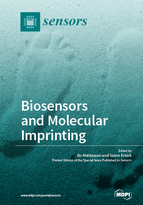Biosensors and Molecular Imprinting
A special issue of Sensors (ISSN 1424-8220). This special issue belongs to the section "Biosensors".
Deadline for manuscript submissions: closed (31 January 2017) | Viewed by 99030
Special Issue Editors
Interests: bio-separation; immobilized enzymes; environmental biotechnology; extremophilic microorganisms; biosensors; immune-analysis and molecularly imprinted polymers
Special Issues, Collections and Topics in MDPI journals
Interests: biochemistry; biosensors; molecularly imprinted polymers
Special Issue Information
Dear Colleagues,
One of the bottlenecks in applying biosensors for real-life applications, e.g., process monitoring or work at ambient temperature, is a lack of stability of the used biorecognition elements, such as antibodies, receptors, enzymes, etc.
Molecularly imprinted polymers (MIPs) represent an attractive way to circumvent many of the obstacles connected to use of biorecognition elements. This Special Issue is devoted to covering MIP-based “bio”-sensors.
MIPs are said to be selective, stable, and represent good binding properties. These aspects are going to be highlighted in this Special Issue, which will cover different aspects of modes to produce MIPs, different sensor configurations, and in a range of different applications. Some reviews constitute the backbone of the Special Issue, and there is room for many regular research papers, as well as mini reports (provided they do not overlap too much with the planned reviews).
Prof. Dr. Bo Mattiasson
Dr. Gizem Ertürk
Guest Editors
Manuscript Submission Information
Manuscripts should be submitted online at www.mdpi.com by registering and logging in to this website. Once you are registered, click here to go to the submission form. Manuscripts can be submitted until the deadline. All submissions that pass pre-check are peer-reviewed. Accepted papers will be published continuously in the journal (as soon as accepted) and will be listed together on the special issue website. Research articles, review articles as well as short communications are invited. For planned papers, a title and short abstract (about 100 words) can be sent to the Editorial Office for announcement on this website.
Submitted manuscripts should not have been published previously, nor be under consideration for publication elsewhere (except conference proceedings papers). All manuscripts are thoroughly refereed through a single-blind peer-review process. A guide for authors and other relevant information for submission of manuscripts is available on the Instructions for Authors page. Sensors is an international peer-reviewed open access semimonthly journal published by MDPI.
Please visit the Instructions for Authors page before submitting a manuscript. The Article Processing Charge (APC) for publication in this open access journal is 2600 CHF (Swiss Francs). Submitted papers should be well formatted and use good English. Authors may use MDPI's English editing service prior to publication or during author revisions.
Keywords
- Biosensors
- Molecularly imprinted polymers
- Biorecognition elements







